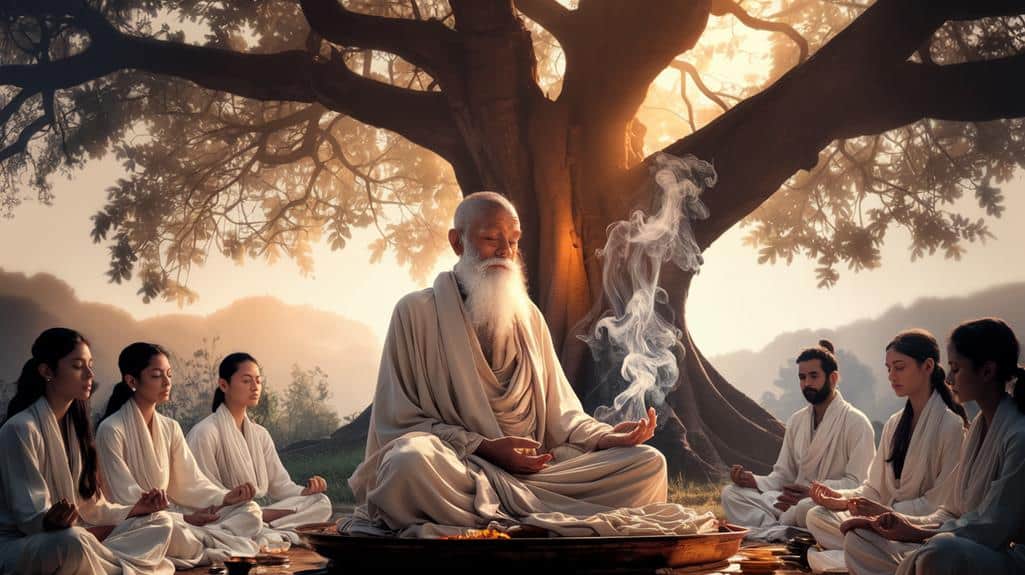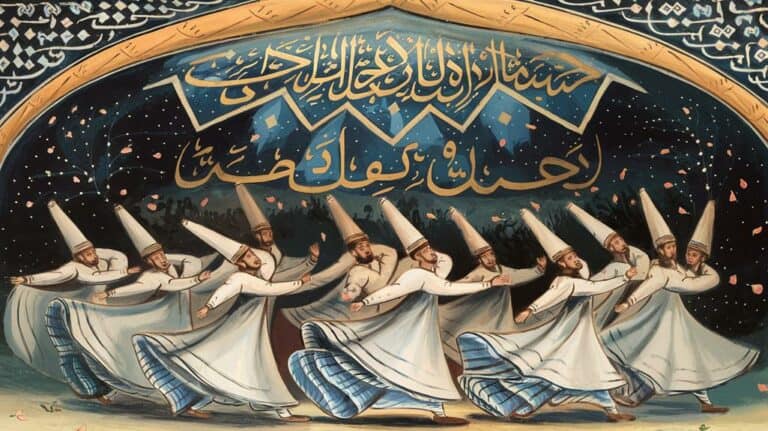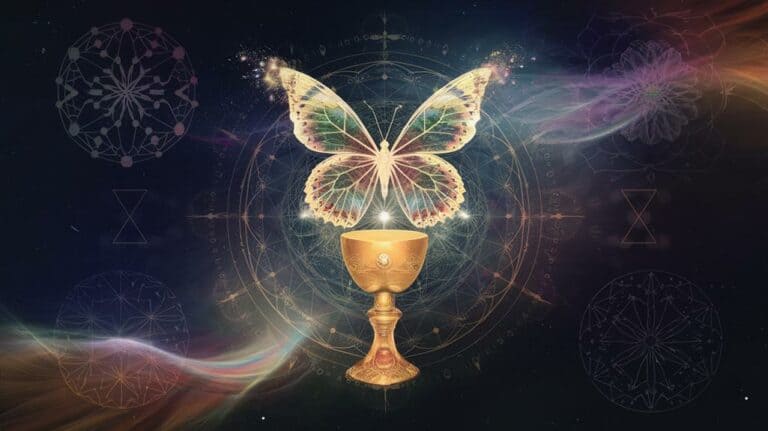The Role of Spiritual Teachers and Gurus in Mystical Traditions
When you’re seeking spiritual understanding, you’ll often find yourself drawn to those who seem to possess the wisdom you desire. Throughout history, these enlightened guides—whether called gurus, masters, or teachers—have served as bridges between the mundane and the mystical. They’ve held the keys to ancient knowledge and transformative practices that can’t simply be learned from books or websites. Yet as you consider starting on this sacred journey of student and teacher, you’ll need to understand both the profound potential and the inherent risks of placing your spiritual development in another’s hands.
The Ancient Origins of Guidance
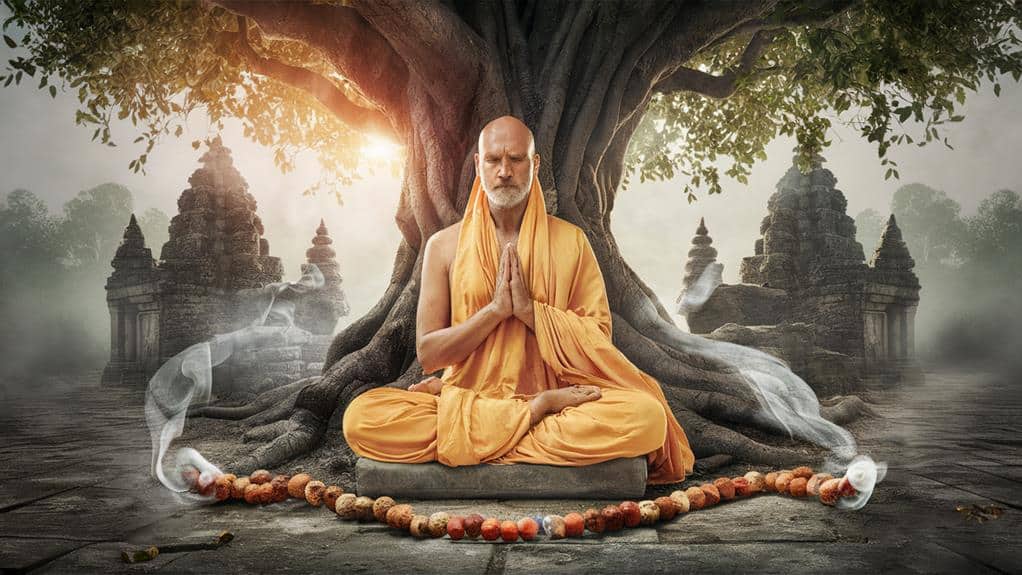
Seekers of wisdom have turned to spiritual teachers since the dawn of human civilization. In the misty depths of prehistory, you’d have found shamanic guides leading others through sacred rituals, helping them pierce the veil between ordinary reality and mystical domains.
These earliest spiritual mentors understood the profound human need for guidance through life’s most challenging transitions and transformations.
You’ll discover that ancient Egypt’s mystery schools established formal teacher-student relationships that would influence spiritual traditions for millennia to come. The great temples weren’t just places of worship – they were centers of initiation where experienced priests guided aspirants through carefully structured stages of awakening.
In India’s Vedic traditions, you’ll find the roots of the guru-disciple relationship that’s become a cornerstone of Eastern spirituality.
These ancient forms of guidance weren’t simply about transmitting information – they were living bridges between the visible and invisible worlds.
You’re inheriting a legacy where wisdom flows through direct transmission from teacher to student, a sacred bond that’s helped countless souls navigate the pathways to higher consciousness.
Defining Sacred Teacher-Student Relationships
Trust forms the bedrock of sacred teacher-student relationships in mystical traditions. You’ll find this sacred bond transcends ordinary human connections, reaching into domains where wisdom flows like water between vessels.
When you enter this hallowed space of learning, you’re stepping into an ancient stream that’s carried spiritual knowledge across generations.
In this sacred relationship, you’re called to open yourself with discernment and vulnerability, while your teacher holds space for your transformation. You’ll discover that authentic spiritual guidance isn’t about blind following, but rather about awakening your inner knowing through the mirror of someone who’s walked the path before you.
The teacher reflects your highest potential, challenging you to shed layers of illusion while supporting your unique journey.
You’re entering a dance of mutual respect and dedication, where boundaries remain clear yet permeable to divine grace. Your teacher’s role isn’t to give you answers but to help you formulate better questions, guiding you toward your own revelations.
This sacred connection becomes a vessel for transmission of not just knowledge, but direct experience of spiritual truths.
Transmission of Esoteric Knowledge
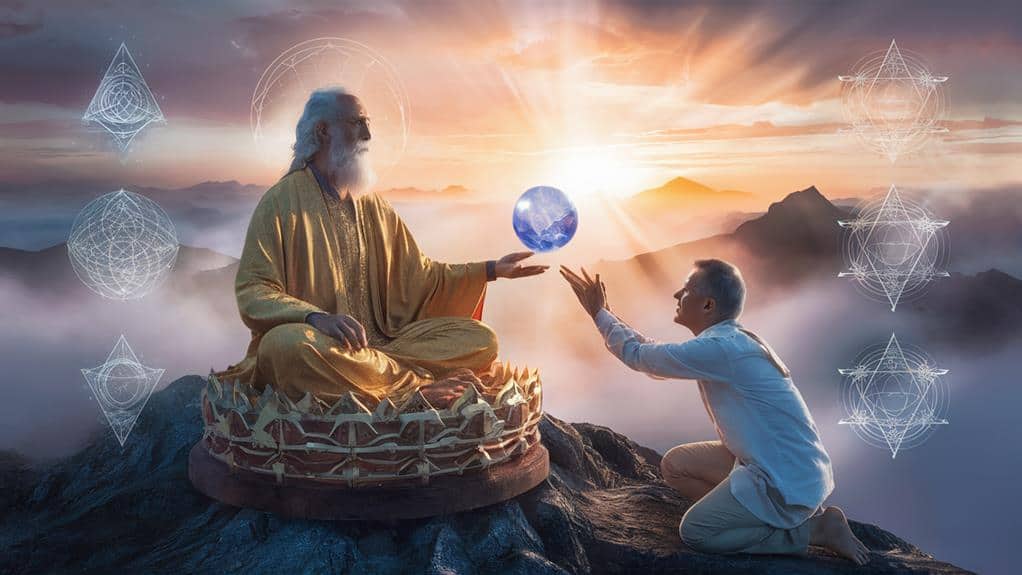
Within the sacred teacher-student bond lies a deeper purpose: the passing of esoteric knowledge that can’t be found in books or lectures alone.
You’ll discover that this transmission flows through subtle channels of consciousness, where wisdom passes from heart to heart in ways that transcend ordinary communication.
As you navigate this mystical territory, you’ll encounter teachings that reveal themselves layer by layer, like petals slowly unfurling in the morning light.
The guru serves as a living bridge between ancient wisdom and your present awareness, channeling timeless truths through direct experience rather than mere intellectual understanding.
You’re not just receiving information; you’re being initiated into a living stream of knowledge that’s been carefully preserved through generations of realized beings.
This transmission operates on multiple levels simultaneously – through spoken word, energy transfer, and silent presence.
You’ll find that the most profound teachings often come through wordless exchanges, where your teacher’s state of consciousness catalyzes transformative shifts in your own awareness.
It’s through this intimate spiritual alchemy that you’ll access the deepest mysteries of your tradition’s esoteric core.
Methods of Spiritual Instruction
Traditional spiritual instruction employs diverse methods to guide students along their path of inner development. You’ll find that these approaches often weave together direct transmission, metaphorical teaching, and experiential practices that challenge your established patterns of thinking and being. Through these methods, you’re invited to discover truths that can’t be conveyed through words alone.
Within the sacred space of teacher-student relationships, you’ll encounter practices like meditation, contemplative inquiry, and ritualized ceremonies that serve as vehicles for deeper understanding. You’re often asked to engage in paradoxical koans or riddles that crack open your conventional mental frameworks, allowing wisdom to emerge from within.
The teacher may use silence as a powerful tool, creating spaces where you’re compelled to face yourself without the usual distractions of daily life. As you progress, you’ll notice how these methods adapt to your level of understanding, shifting from basic instruction to more subtle forms of guidance.
The teacher’s role isn’t to give you answers but to illuminate the path where you’ll find your own insights, helping you recognize the wisdom that already dwells within your consciousness.
Cultural Variations Across Traditions
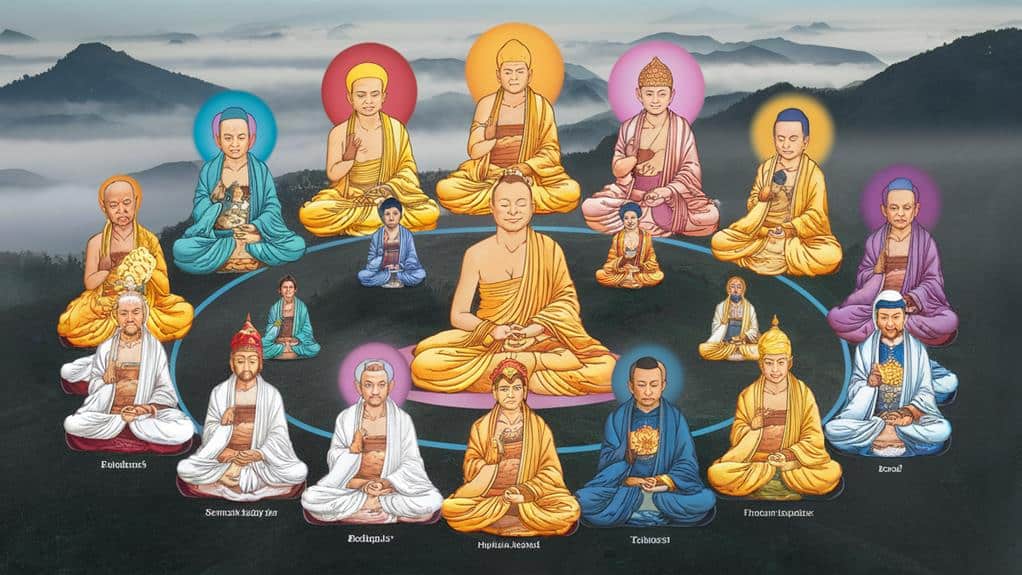
Exploring spiritual traditions across cultures reveals distinct approaches to the teacher-student relationship. In Eastern traditions, you’ll find a deep reverence for the guru-disciple bond, where surrendering to a master’s guidance is seen as essential for spiritual advancement. The Sanskrit term “guru” itself implies someone who dispels darkness, while Zen Buddhism‘s roshi serves as a mirror reflecting your true nature back to you.
In Western mystical traditions, you’ll encounter a more collaborative dynamic, where spiritual directors or mentors walk alongside you rather than assuming complete authority. The Desert Fathers of early Christianity emphasized direct experience through contemplative practice, while Sufi sheikhs guide through poetry, music, and movement to reveal divine wisdom.
Jewish mysticism’s approach centers on the learned scholar who illuminates sacred texts while encouraging personal interpretation.
You’ll notice that despite these cultural differences, certain universal elements persist: the recognition that spiritual growth often requires guidance, the emphasis on direct transmission of wisdom, and the understanding that the teacher-student relationship transforms as you progress along your path.
These variations offer you multiple gateways to truth’s infinite expressions.
Challenges on the Teaching Path
Charting the spiritual teaching path presents significant challenges for both teachers and students. You’ll find that the delicate balance between offering guidance and fostering independence requires constant recalibration as each seeker’s journey unfolds in uniquely personal ways.
The teacher must discern when to illuminate the path and when to let students navigate their own darkness, knowing that essential wisdom often emerges through direct experience.
You’re faced with the challenge of maintaining authenticity while adapting ancient teachings to contemporary understanding. As you translate timeless wisdom into modern contexts, you’ll need to preserve the depth of traditional insights while making them accessible to today’s seekers.
The path demands vigilance against the ego’s subtle infiltrations, both in teaching and learning, as spiritual authority can become a dangerous trap.
You must navigate the paradox of using words to point toward that which transcends language, knowing that the ultimate truth lies beyond conceptual frameworks.
The greatest challenge remains: helping others discover their inner teacher while acknowledging that true transformation can’t be given but must be realized through one’s own deepening awareness.
Modern Evolution of Spiritual Leadership

Contemporary spiritual leadership has undergone three fundamental shifts: from hierarchical to collaborative models, from isolated ashrams to global digital communities, and from dogmatic teachings to experiential wisdom.
You’ll find today’s spiritual guides often serving as facilitators rather than authority figures, creating spaces where you’re encouraged to discover your own truth while being supported by collective wisdom.
In this evolving landscape, you’re witnessing the emergence of teachers who’ve integrated ancient wisdom with modern understanding, bridging Eastern mysticism with Western psychology and indigenous knowledge with scientific insights.
You’ll notice how social media platforms and online forums have transformed the teacher-student relationship, allowing you to engage with multiple perspectives and choose your level of involvement.
Yet within this digital transformation, you’re called to navigate the delicate balance between accessibility and authenticity.
While you can now access spiritual teachings from your smartphone, the depth of transformation still requires your dedicated practice and genuine self-inquiry.
The modern spiritual journey invites you to become both a student and teacher, recognizing that true wisdom emerges from your lived experience rather than mere intellectual understanding.
Authenticity and False Teachers
Through the ages, distinguishing authentic spiritual teachers from false ones has remained a critical challenge in mystical traditions. You’ll find that genuine teachers often exhibit profound humility, while false ones frequently display an insatiable need for adoration and material wealth.
When you’re seeking spiritual guidance, you’ll notice that authentic masters don’t demand blind devotion but instead encourage you to question, explore, and discover truth through your own direct experience.
You’ll recognize authentic teachers by their consistency between teachings and actions, their lack of exploitation, and their ability to point beyond themselves toward universal truths. They won’t claim exclusive access to spiritual wisdom or create dependency, but rather empower you to develop your own discernment.
In contrast, false teachers often manipulate through fear, shame, or promises of special powers, creating hierarchies that serve their ego rather than their students’ growth.
As you navigate your spiritual path, remember that true masters illuminate the way without casting shadows of doubt or dependency. They’ll inspire you to find your own inner light while remaining grounded in ethical principles that transcend cultural and temporal boundaries.
Finding Your Spiritual Guide

The search for a genuine spiritual guide requires careful discernment and patient observation. You’ll find that authentic teachers emerge naturally in your life when you’re truly ready, often appearing in unexpected ways and places. As you navigate this sacred journey, trust your intuition while remaining grounded in rational discernment.
Begin by examining your own readiness and motivations. You’ll know you’re prepared when you’re seeking wisdom rather than escape, transformation rather than mere comfort.
Watch potential teachers from a distance first, observing how they interact with others and whether their actions align with their teachings. Notice if they encourage your independence rather than foster dependency.
Your ideal guide won’t demand devotion or claim absolute authority, but rather will illuminate your own inner wisdom. They’ll challenge your assumptions while respecting your autonomy, offering guidance without imposing rigid doctrines.
Pay attention to how you feel in their presence – authentic teachers typically emanate a sense of peace and clarity rather than urgency or pressure.



